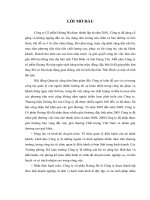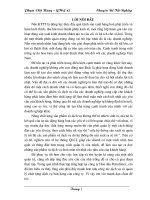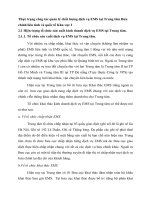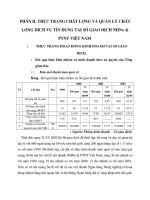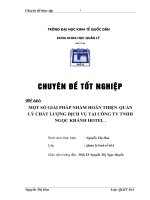Service quality: implications for management development
Bạn đang xem bản rút gọn của tài liệu. Xem và tải ngay bản đầy đủ của tài liệu tại đây (48.66 KB, 9 trang )
International Journal of Quality & Reliability Management
Emerald Article: Service quality: implications for management development
Atul Gupta, Injazz Chen
Article information:
To cite this document: Atul Gupta, Injazz Chen, (1995),"Service quality: implications for management development", International
Journal of Quality & Reliability Management, Vol. 12 Iss: 7 pp. 28 - 35
Permanent link to this document:
/>Downloaded on: 15-01-2013
References: This document contains references to 7 other documents
Citations: This document has been cited by 9 other documents
To copy this document:
This document has been downloaded 2596 times since 2005. *
Users who downloaded this Article also downloaded: *
Atul Gupta, Injazz Chen, (1995),"Service quality: implications for management development", International Journal of Quality &
Reliability Management, Vol. 12 Iss: 7 pp. 28 - 35
/>Atul Gupta, Injazz Chen, (1995),"Service quality: implications for management development", International Journal of Quality &
Reliability Management, Vol. 12 Iss: 7 pp. 28 - 35
/>Atul Gupta, Injazz Chen, (1995),"Service quality: implications for management development", International Journal of Quality &
Reliability Management, Vol. 12 Iss: 7 pp. 28 - 35
/>Access to this document was granted through an Emerald subscription provided by UNIVERSITY OF ECONOMICS HO CHI MINH
For Authors:
If you would like to write for this, or any other Emerald publication, then please use our Emerald for Authors service.
Information about how to choose which publication to write for and submission guidelines are available for all. Please visit
www.emeraldinsight.com/authors for more information.
About Emerald www.emeraldinsight.com
With over forty years' experience, Emerald Group Publishing is a leading independent publisher of global research with impact in
business, society, public policy and education. In total, Emerald publishes over 275 journals and more than 130 book series, as
well as an extensive range of online products and services. Emerald is both COUNTER 3 and TRANSFER compliant. The organization is
a partner of the Committee on Publication Ethics (COPE) and also works with Portico and the LOCKSS initiative for digital archive
preservation.
*Related content and download information correct at time of download.
IJQRM
12,7
28
Service quality: implications
for management development
Atul Gupta and Injazz Chen
Department of Quantitative Business Analysis, Cleveland State
University, Cleveland, Ohio, USA
Introduction
Service quality is one of the major issues facing operations managers. Some of
the reasons for the importance of service quality are:
●
The economy of the USA and other western nations has become a service
economy. For example, in the USA service accounts for approximately
three-quarters of the gross national product and nine of the ten jobs the
economy creates.
●
In the first two years during which the much renowned Malcolm
Baldrige National Quality Awards were granted to US companies, not a
single service company met the minimum quality standards established.
However, recently Federal Express, a service company, was given the
Malcolm Baldrige National Quality Award.
This article attempts to define perceived service quality, relate the concepts of
perceived service quality and its five dimensions in service operations, and
provide the implications of the relation between service quality and its
dimensions on management development.
To the authors’ knowledge no one has yet attempted to assess the
implications of the relationship between service quality and its five dimensions
for management development. This analysis will not only provide managers
with the information about the dynamics of service organizations but also
suggest some solutions in terms of management development and training.
Perceived service quality
There are differences between services and goods in terms of how they are
produced, consumed, and evaluated. Table I, which is similar to that of
Zemke[1], points to the characteristics that distinguish a service from a product.
Services are performances, rather than objects. Chase and Tansik[2] classified
services based on consumer contact. The extent of consumer contact with the
service organizations was used as a means of differentiating types of service
systems. Three types of services identified are:
(1) Pure service. Organizations in which the customer must be present for
service production (e.g. fast-food restaurant, nursing home).
(2) Mixed service. Organizations in which there is both face-to-face as well as
back office contact with the customer (e.g. commercial airline).
International Journal of Quality
& Reliability Management,
Vol. 12 No. 7, 1995, pp. 28-35,
© MCB University Press,
0265-671X
Service quality
29
(3) Quasi-manufacturing service. Organizations in which there is no face-to-
face contact with the customer (e.g. credit card, long distance telephone
company).
Most of the literature on quality is predominantly goods oriented, but a few
articles have focused on service quality[3,4]. Moreover, the three characteristics
of services – intangibility, heterogeneity and inseparability – are also well
documented[5]. As pointed out by Zeithaml et al.[6], the following three themes
emerge from these studies:
(1) Customers do not evaluate service solely on the outcome of a service;
they also consider the process of service delivery.
(2) It is more difficult for the customer to evaluate service quality than goods
quality. Zemke[1] points out that it is harder to create service
measurements that are effective. With a physical product, it is possible to
measure quality in terms of specifications using engineering
measurement tools and techniques. The common standard for service
quality is customer perception. It is harder to measure customer
perception because each customer has his/her own specification in mind
for each service experience. Moreover, because of service intangibility,
firms may find it more difficult to understand how consumers perceive
service quality.
(3) The criteria consumers use for evaluating service quality are based on
the comparison of consumer expectations with the actual service
performance. Thus the perceived service quality is based on consumers’
judgement about a service’s overall excellence or superiority. Perceived
service quality is different from the actual goods quality because it
involves a higher level of abstraction rather than a specific attribute of a
Table I.
Some differences
between a product and
a service
Product Service
The customer owns the object The customer owns the memory with experiences
which cannot be sold or passed on
The goal is to produce uniformity in The goal of service is uniqueness
product
A product can be put into inventory A service cannot be stockpiled
The customer is an end user who is not The customer is a co-producer who is a partner in
involved in the production process creating the service
One conducts quality control by Customers conduct quality control by comparing
comparing output to specifications expectations to experience
A defective product can be recalled or A bad or defective service cannot be recalled
rejected
IJQRM
12,7
30
product, and a judgement is usually made within a consumer’s evoked
set.
In a study of four consumer service industries, Parasuraman et al.[7] identify
five quality dimensions which link specific service characteristics to consumer
expectations of quality. These five basic dimensions are:
(1) Tangibles. Physical facilities, equipment, and appearance of personnel.
(2) Reliability. Ability to perform the promised service dependably and
accurately.
(3) Responsiveness. Willingness to help customers and provide prompt
service.
(4) Assurance. Knowledge and courtesy of employees and their ability to
convey trust and confidence.
(5) Empathy. Caring, individualized attention provided to customers.
SERVQUAL, an instrument for measuring service quality was developed on the
basis of the above five dimensions. SERVQUAL has been gaining acceptance as
a platform for work in service quality.
Methodology
The five service dimensions of service quality were measured with an
instrument known as SERVQUAL[7]. SERVQUAL is a seven-point Likert scale
which measures consumer expectations and perceptions of the service quality.
Service quality is determined using gap analysis (i.e. the difference between
expectations and perceptions of quality) (see Figure 1). The SERVQUAL score
for each statement pair, for each customer, is computed as follows:
SERVQUAL score = perception score – expectation score.
The SERVQUAL score along each dimension is obtained by adding the
SERVQUAL scores on the statements pertaining to the dimension and then
dividing the sum by the number of statements making up the dimension.
SERVQUAL was used to collect data for all the three types of services: a fast-
food restaurant for pure service, an airline for mixed service, and a long-
distance telephone company for quasi-manufacturing service. A SERVQUAL
questionnaire was given to 110 consumers for each of the three services. Of the
110 questionnaires distributed, the response rate was as follows:
Perception of
service experience
* * * *
What customers
perceive service
provider actually
offered
Expectation of
service experience
* * * *
What customers
believe the service
provider should offer
Service
quality
–=
Figure 1.
Measurement of
SERVQUAL service
quality
Service quality
31
●
long-distance telephone company: 78 (71 per cent);
●
fast-food restaurant: 65 (59 per cent);
●
airline: 69 (63 per cent).
In addition to the 22 items on SERVQUAL, the respondents were asked to rate
the overall quality of service operations on a seven-point Likert scale. We used
a seven-point Likert scale instead of a four-point one as used by Parasuraman
et al.[7] because it will give a better normal spread of observations. The reason
for having a separate question for measuring the overall quality is that using
the average of measured gaps (SERVQUAL) will result in multi-collinearity. The
result from the separate question on overall quality measurement was used for
the regression purposes.
Data for each of the three services were then analysed by regressing the
scores of the perceived quality of service by the consumer on five dimensions of
service quality as defined by Parasuraman et al.[5] on a seven-point Likert
scale.
Further, an exploratory study was undertaken with two groups of human
resource managers from the three types of services under study. The
participants were specifically screened to make sure that each participant had
at least two years of association with the organizations in question. One of the
members of the research team served as a moderator for each focus group. Our
findings were then shared with the members of the focus groups. Focus group
participants were then asked about their input in regard to the implications of
our findings for training and management development.
Results
The results of the analysis are presented in Table II. The adjusted R
2
values are
statistically significant in all the three types of services. Out of the three types
of services, the pure service (long-distance telephone) has the highest R
2
,
implying that this model accounts for more of the variance in service quality
than the other two models.
A striking result in terms of service quality dimensions is the statistically
significant relationship between perceived service quality and reliability for all
the three types of services. Reliability is the most important dimension in
determining service quality for all the three types of services. For example, in
the case of an airline, the consumer may have higher satisfaction if the airline
provides dependability of flight arrivals and departures.
Tangibles is the other important critical variable for the mixed service.
Empathy is critical variable for the quasi-manufacturing services, implying
that caring and individualized attention affect the customer’s perceived
satisfaction. The results of the statistical analysis were then shared with the
members of two focus groups. The focus group members in turn shared their
views in regard to what could be done in terms of training and management
development for the three types of services.
